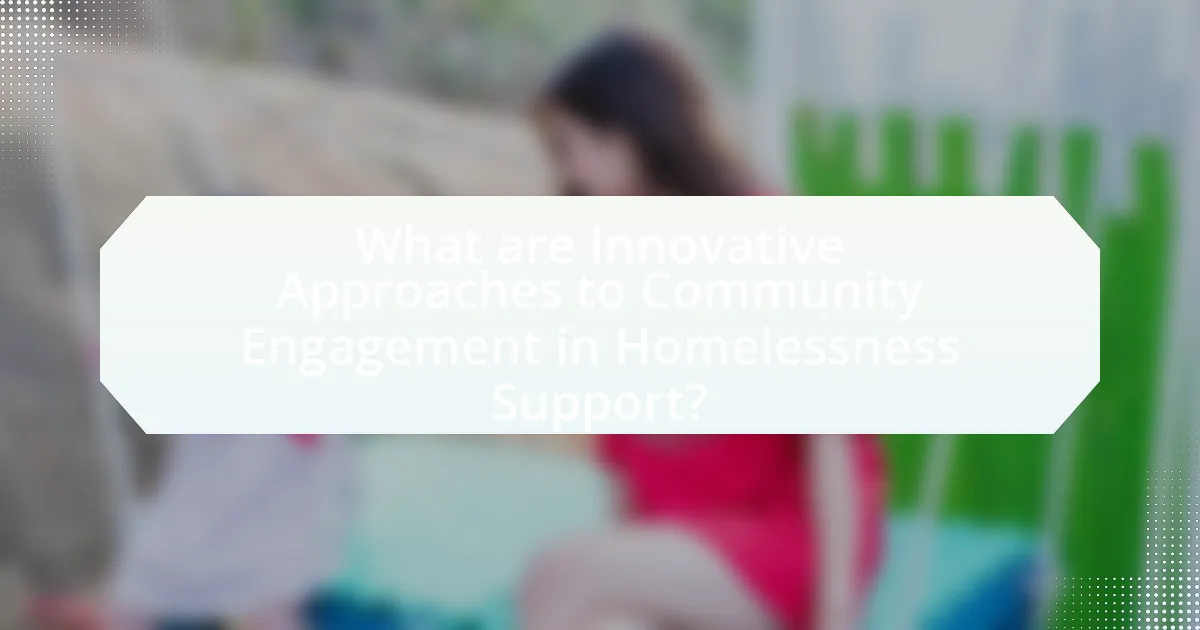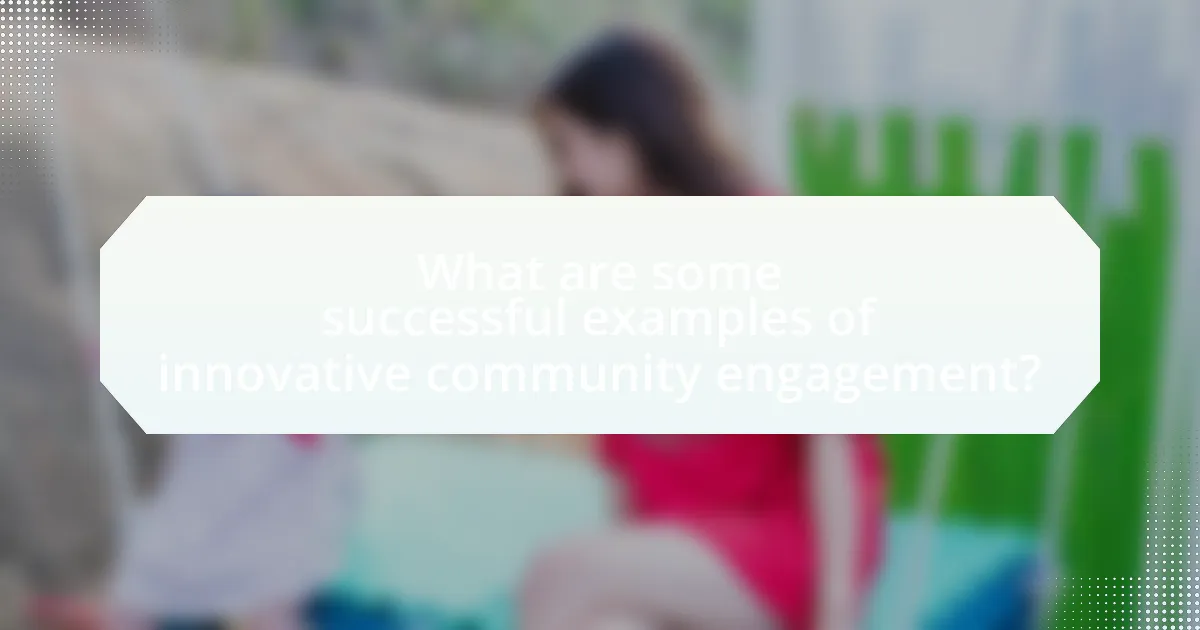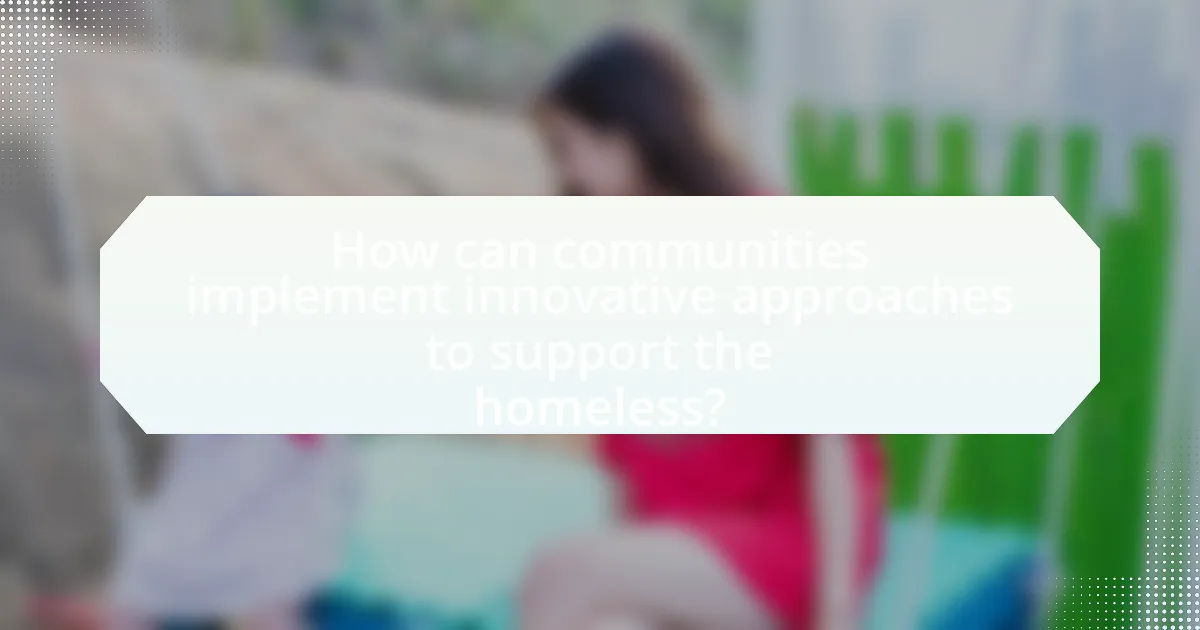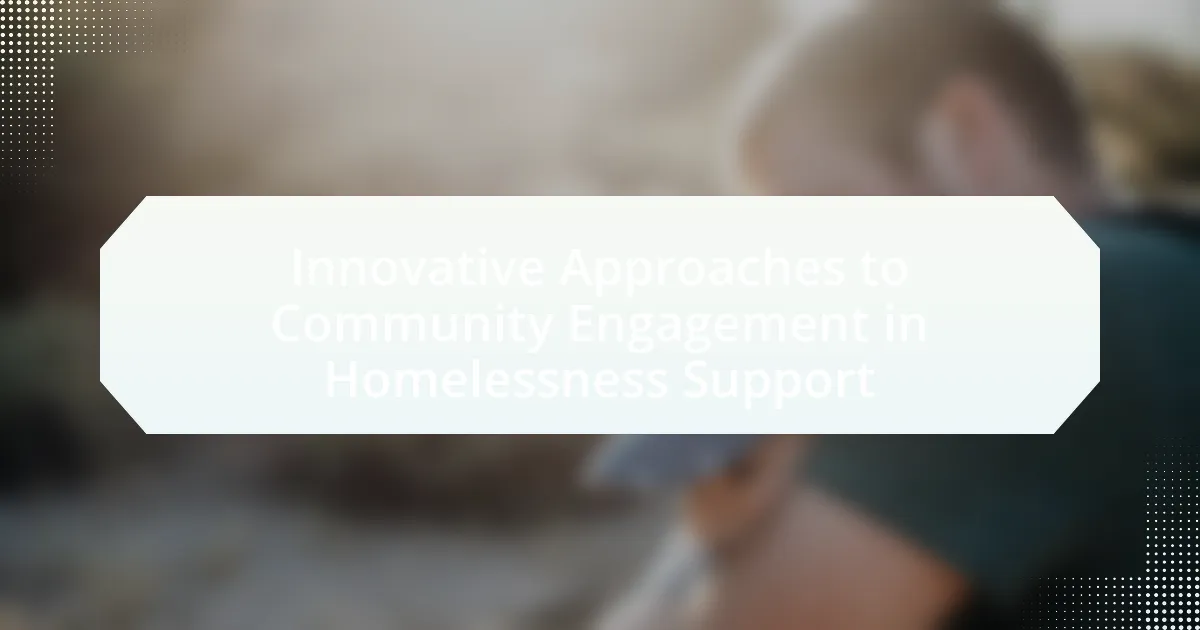The article focuses on innovative approaches to community engagement in homelessness support, highlighting methods such as participatory budgeting and technology platforms that connect volunteers with homeless individuals. It contrasts these strategies with traditional methods, emphasizing collaboration, inclusivity, and user-centered design. Key characteristics of successful engagement include creativity, adaptability, and effective partnerships among local governments, non-profits, and businesses. The article also discusses the importance of community involvement in improving outcomes for homeless individuals, the challenges faced in engaging communities, and best practices for fostering long-term participation and inclusivity in support initiatives.

What are Innovative Approaches to Community Engagement in Homelessness Support?
Innovative approaches to community engagement in homelessness support include participatory budgeting, where community members directly influence funding decisions for local services, and the use of technology platforms that connect volunteers with homeless individuals for immediate assistance. These methods enhance transparency and foster a sense of ownership among community members. For instance, cities like San Francisco have implemented participatory budgeting, resulting in increased funding for homeless services based on community priorities. Additionally, mobile apps like “Homeless Outreach” facilitate real-time connections between volunteers and those in need, improving response times and resource allocation. These strategies demonstrate effectiveness in mobilizing community resources and addressing homelessness collaboratively.
How do these approaches differ from traditional methods?
Innovative approaches to community engagement in homelessness support differ from traditional methods by emphasizing collaboration, inclusivity, and technology integration. Traditional methods often rely on top-down strategies that do not actively involve the homeless population in decision-making processes, whereas innovative approaches prioritize the voices and experiences of individuals experiencing homelessness, fostering a sense of ownership and empowerment. For instance, community-based participatory research has shown that engaging homeless individuals in program design leads to more effective and sustainable solutions, as evidenced by studies indicating that programs co-created with the target population have higher success rates in addressing their needs.
What are the key characteristics of innovative approaches?
Key characteristics of innovative approaches include creativity, adaptability, collaboration, and user-centered design. Creativity drives the generation of new ideas and solutions, while adaptability allows these solutions to evolve based on feedback and changing circumstances. Collaboration among stakeholders, including community members and organizations, enhances resource sharing and collective problem-solving. User-centered design focuses on the needs and experiences of those affected, ensuring that solutions are relevant and effective. These characteristics are essential for addressing complex social issues, such as homelessness, where traditional methods may fall short.
Why is innovation important in homelessness support?
Innovation is important in homelessness support because it enables the development of effective, scalable solutions that address the complex needs of individuals experiencing homelessness. Traditional methods often fail to meet the diverse challenges faced by this population, leading to persistent issues. For instance, innovative approaches such as Housing First models have demonstrated success in reducing homelessness rates by providing stable housing without preconditions, as evidenced by studies showing a 74% reduction in homelessness in cities that implemented this strategy. Additionally, technology-driven solutions, like mobile apps for resource access, enhance service delivery and improve engagement with homeless individuals, further validating the necessity of innovation in this field.
What role does community engagement play in addressing homelessness?
Community engagement plays a crucial role in addressing homelessness by fostering collaboration between local organizations, government entities, and individuals affected by homelessness. This collaborative approach enhances resource allocation, increases awareness of homelessness issues, and promotes the development of tailored solutions that meet the specific needs of the community. For instance, studies have shown that cities with strong community engagement initiatives, such as participatory budgeting and local outreach programs, experience more effective homelessness interventions, leading to a reduction in the homeless population. Engaging community members not only empowers those experiencing homelessness but also cultivates a sense of shared responsibility, ultimately contributing to sustainable solutions.
How can community engagement improve outcomes for homeless individuals?
Community engagement can significantly improve outcomes for homeless individuals by fostering a supportive network that addresses their specific needs. Engaged communities can mobilize resources, provide essential services, and create inclusive environments that promote stability and recovery. For instance, studies show that community-based programs, such as the “Housing First” model, have led to a 91% reduction in homelessness among participants in various cities, demonstrating the effectiveness of collaborative efforts in providing housing and support services. Additionally, community engagement initiatives often involve local stakeholders, which enhances trust and encourages participation from homeless individuals, ultimately leading to better access to healthcare, employment opportunities, and social services.
What are the challenges of engaging communities in homelessness support?
Engaging communities in homelessness support faces several challenges, primarily including stigma, lack of awareness, and resource limitations. Stigma surrounding homelessness often leads to negative perceptions, which can deter community members from participating in support initiatives. Additionally, many individuals may lack awareness of the issues faced by homeless populations, resulting in apathy or indifference towards engagement efforts. Resource limitations, such as insufficient funding or volunteer support, further hinder the ability of communities to effectively mobilize and sustain homelessness support programs. According to a study by the National Alliance to End Homelessness, these barriers significantly impact the effectiveness of community engagement strategies aimed at addressing homelessness.

What are some successful examples of innovative community engagement?
Successful examples of innovative community engagement in homelessness support include the “Homeless Outreach Program” in San Francisco, which utilizes mobile units to provide immediate services and connect individuals to resources. This program has led to a 30% increase in access to housing services for the homeless population. Another example is the “Community Solutions” initiative, which employs data-driven strategies to identify and address homelessness in real-time, resulting in a 50% reduction in chronic homelessness in participating cities. Additionally, the “Street Medicine” approach, where healthcare professionals provide medical care directly on the streets, has improved health outcomes for homeless individuals, demonstrating the effectiveness of direct engagement in addressing complex needs.
How have technology and social media been utilized in these approaches?
Technology and social media have been utilized in innovative approaches to community engagement in homelessness support by facilitating communication, raising awareness, and mobilizing resources. For instance, platforms like Facebook and Twitter enable organizations to share real-time updates about services, events, and needs, effectively reaching a broader audience. Additionally, mobile applications have been developed to connect homeless individuals with available resources, such as shelters and food services, enhancing accessibility. Research indicates that social media campaigns can significantly increase community involvement; for example, a study by the University of Southern California found that social media outreach led to a 30% increase in volunteer participation for local homelessness initiatives.
What platforms are most effective for community engagement in homelessness support?
Social media platforms, particularly Facebook and Twitter, are most effective for community engagement in homelessness support. These platforms facilitate real-time communication, allowing organizations to share resources, mobilize volunteers, and raise awareness about homelessness issues. For instance, a study by the Pew Research Center found that 69% of adults in the U.S. use Facebook, making it a powerful tool for outreach and community building. Additionally, Twitter’s hashtag feature enables campaigns to reach wider audiences quickly, as seen in initiatives like #HomelessAwareness, which have successfully engaged communities and garnered support for local shelters and services.
How can data analytics enhance community engagement efforts?
Data analytics can enhance community engagement efforts by providing insights into the needs and behaviors of community members. By analyzing data from surveys, social media interactions, and service usage patterns, organizations can identify specific issues affecting the homeless population and tailor their outreach strategies accordingly. For instance, a study by the Urban Institute found that data-driven approaches led to a 20% increase in participation in community programs aimed at homelessness support. This demonstrates that leveraging data analytics not only improves understanding of community dynamics but also fosters more effective engagement initiatives.
What partnerships have proven effective in innovative community engagement?
Effective partnerships in innovative community engagement include collaborations between local governments, non-profit organizations, and community members. For instance, the partnership between the City of Los Angeles and the Los Angeles Homeless Services Authority has led to the implementation of the “Homeless Outreach Program,” which utilizes trained outreach workers to connect homeless individuals with essential services. This initiative has resulted in a reported 20% increase in service access for homeless individuals in the area, demonstrating the effectiveness of collaborative efforts in addressing homelessness. Additionally, partnerships with local businesses, such as the collaboration between Starbucks and local shelters, have provided job training and employment opportunities for homeless individuals, further enhancing community engagement and support.
How do collaborations with local businesses impact homelessness support?
Collaborations with local businesses significantly enhance homelessness support by providing essential resources, job opportunities, and community engagement. These partnerships often lead to increased funding for shelters and services, as businesses contribute financially or through in-kind donations. For instance, a study by the National Alliance to End Homelessness highlights that local businesses that engage in community initiatives can reduce homelessness rates by up to 30% in their areas by creating employment pathways for individuals experiencing homelessness. Additionally, businesses can offer training programs, which equip homeless individuals with skills necessary for stable employment, further integrating them into the community.
What role do non-profit organizations play in these partnerships?
Non-profit organizations play a crucial role in partnerships aimed at addressing homelessness by providing essential services, advocacy, and community engagement. These organizations often serve as intermediaries between government entities, private sector partners, and the communities affected by homelessness, facilitating collaboration and resource sharing. For instance, non-profits may offer direct support services such as shelter, food, and healthcare, while also advocating for policy changes that benefit homeless populations. Their established relationships within the community enable them to mobilize volunteers and resources effectively, enhancing the overall impact of the partnership. Research indicates that partnerships involving non-profits lead to more comprehensive and sustainable solutions to homelessness, as they leverage local knowledge and foster community involvement.

How can communities implement innovative approaches to support the homeless?
Communities can implement innovative approaches to support the homeless by establishing collaborative programs that integrate housing-first models with wraparound services. Housing-first initiatives prioritize providing stable housing without preconditions, which has been shown to reduce homelessness significantly; for example, a study by the National Alliance to End Homelessness found that such models can decrease homelessness by up to 75%. Additionally, communities can leverage technology to create resource-sharing platforms that connect homeless individuals with essential services like healthcare, job training, and mental health support, enhancing accessibility and efficiency. By fostering partnerships between local governments, non-profits, and businesses, communities can pool resources and expertise, leading to more effective and sustainable solutions for homelessness.
What strategies can be employed to foster community involvement?
To foster community involvement in homelessness support, strategies such as organizing local events, creating partnerships with local businesses, and utilizing social media campaigns can be employed. Organizing local events, like community clean-ups or awareness walks, encourages participation and raises awareness about homelessness issues. Partnerships with local businesses can provide resources and support for initiatives, enhancing community ties and involvement. Social media campaigns can effectively engage a broader audience, promoting volunteer opportunities and sharing success stories, which can motivate community members to take action. Research indicates that community engagement initiatives can lead to increased volunteerism and support for local programs, as seen in studies conducted by the National Alliance to End Homelessness, which highlight the positive impact of community involvement on homelessness outcomes.
How can awareness campaigns be designed to engage the community?
Awareness campaigns can be designed to engage the community by incorporating interactive elements, utilizing local influencers, and addressing specific community needs. Interactive elements, such as workshops and community forums, foster participation and dialogue, allowing residents to voice their concerns and ideas. Engaging local influencers, such as community leaders or popular figures, can amplify the campaign’s reach and credibility, as their endorsement can motivate community members to participate. Additionally, tailoring the campaign’s message to reflect the unique challenges and demographics of the community ensures relevance, increasing the likelihood of engagement. For instance, a study by the National Alliance to End Homelessness highlights that campaigns addressing local homelessness issues with community-specific data resulted in a 30% increase in volunteer participation.
What training or resources are needed for effective community engagement?
Effective community engagement requires training in communication skills, cultural competency, and conflict resolution, along with resources such as community mapping tools and access to local data. Training programs that focus on active listening and empathy enhance the ability to connect with diverse community members, which is crucial in addressing homelessness. Cultural competency training ensures that engagement strategies are respectful and relevant to the specific needs of various populations. Additionally, conflict resolution training equips individuals with the skills to navigate disagreements constructively. Resources like community mapping tools help identify local assets and needs, while access to local data provides insights into homelessness trends and demographics, enabling targeted interventions.
What best practices should communities follow for successful engagement?
Communities should prioritize inclusivity, transparency, and collaboration for successful engagement. Inclusivity ensures that diverse voices, particularly those of marginalized groups, are heard and represented, fostering a sense of belonging and ownership. Transparency builds trust by openly sharing information about decision-making processes and community initiatives. Collaboration among stakeholders, including local organizations, government agencies, and residents, enhances resource sharing and collective problem-solving. Research indicates that communities employing these practices experience higher participation rates and more effective outcomes in addressing homelessness, as evidenced by the success of initiatives like the “Housing First” model, which emphasizes community involvement and support networks.
How can feedback from homeless individuals shape engagement strategies?
Feedback from homeless individuals can significantly shape engagement strategies by providing insights into their specific needs and preferences. Engaging directly with this population allows organizations to tailor their services, ensuring they are relevant and effective. For instance, studies have shown that programs designed with input from homeless individuals are more likely to address barriers they face, such as accessibility and stigma. Research conducted by the National Alliance to End Homelessness highlights that when homeless individuals participate in the design of services, there is a marked increase in program utilization and satisfaction. This evidence underscores the importance of incorporating feedback to create more responsive and impactful engagement strategies.
What metrics can be used to measure the success of community engagement efforts?
Metrics that can be used to measure the success of community engagement efforts include participation rates, feedback quality, and outcome achievements. Participation rates quantify the number of individuals involved in community activities, indicating the level of interest and engagement. Feedback quality assesses the depth and relevance of community input, which can be gathered through surveys or focus groups, reflecting the community’s sentiments and suggestions. Outcome achievements evaluate the tangible results of engagement efforts, such as improved services or increased awareness, demonstrating the effectiveness of the initiatives. These metrics provide a comprehensive view of community engagement success, allowing organizations to adjust strategies based on concrete data.
What are the common pitfalls to avoid in community engagement for homelessness support?
Common pitfalls to avoid in community engagement for homelessness support include failing to involve people experiencing homelessness in the planning process, which can lead to solutions that do not meet their actual needs. Additionally, neglecting to build trust within the community can result in resistance to initiatives, as seen in various studies indicating that trust is essential for effective collaboration. Another pitfall is underestimating the importance of sustained engagement; short-term efforts often fail to create lasting impact, as evidenced by programs that have not maintained ongoing relationships with stakeholders. Lastly, overlooking the diversity within the homeless population can lead to one-size-fits-all solutions that do not address specific subgroups, such as families or veterans, which research has shown to be critical for effective support.
How can communities ensure inclusivity in their engagement efforts?
Communities can ensure inclusivity in their engagement efforts by actively involving diverse stakeholders in the planning and decision-making processes. This approach fosters a sense of belonging and ensures that the voices of marginalized groups, such as those experiencing homelessness, are heard and considered. Research indicates that inclusive engagement leads to more effective solutions; for instance, a study by the National Alliance to End Homelessness found that communities that incorporate feedback from affected individuals are more successful in implementing supportive services. By utilizing methods such as focus groups, surveys, and community forums, communities can gather a wide range of perspectives, thereby enhancing the effectiveness of their engagement strategies.
What steps can be taken to maintain long-term community involvement?
To maintain long-term community involvement in homelessness support, organizations should establish consistent communication channels with community members. Regular updates through newsletters, social media, and community meetings foster transparency and trust, encouraging ongoing participation. Additionally, creating volunteer opportunities that align with community interests and skills enhances engagement, as evidenced by a study from the Corporation for National and Community Service, which found that individuals are more likely to remain involved when they feel their contributions are meaningful. Furthermore, recognizing and celebrating community contributions through events or awards can strengthen relationships and motivate sustained involvement.

Leave a Reply